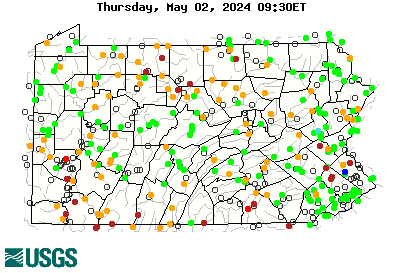Secret stream locations are dead.
While my view may not align with everyone, I have thought about this topic a lot. In fact, I have reflected quite a bit on the potential consequences of naming locations and the role of the Stream Reports Forum.
Historically, many popular books have been written over the decades, sharing fly fishing locations. Riding around with one or more books by Meck or Landis, along with a Delorme PA Atlas, was the norm for any angler exploring new waters. That’s exactly what I did in the ’80s and even the ’90s. Magazines, newspapers, and monthly printed journals found in fly shops were common sources of information. In those early years, there was little official information available from the state—until they began publishing stocking reports in a PDF format in the early 2000s.
At that time, there were probably fewer than a dozen printed media outlets available to Pennsylvania anglers, and they all focused on the same 50 to 100 streams. You can pick up any of those older books and see what I mean. Beyond printed materials, word of mouth from other anglers was another way to learn where to fish. But let’s be honest—anglers have never been very good at keeping secrets.
With the digital age post-2000s, we now have a firehose of information on where to fish. As print media has declined, the list of outlets and stream locations has expanded far beyond the concentrated information of the 1980s. The state publishes online maps of Stocked Streams, Class A Wild Trout Streams, Wilderness Streams, and more. These resources not only provide stream names but also GPS coordinates for hundreds of fishing locations. Add in all the blogs, YouTube channels, Facebook groups, Instagram posts, fly shop reports, forums, and more, and you have literally hundreds of media outlets discussing what could be over a thousand streams in Pennsylvania. Plus, let’s not forget the tens of thousands of private messages exchanged between anglers daily.
Today I ride around with a GPS from Google Maps and pinned fly-fishing parking spots. I no longer worry about going to the stream, just which parking spot I’m looking to find.
We’ve reached the point where you can ask ChatGPT to provide a list of the Top 10 Fly Fishing Streams in Pennsylvania. The response will include stream names, counties, why they’re great, notable hatches, and the best access points. You can even ask for fly fishing locations within a specific county. If you inquire about Centre County, for example, the answer will be Spring Creek, Penns Creek, and Fishing Creek, —but don’t tell anyone.
There are no true secrets anymore—just locations that are a little off the beaten path, waiting to be explored. For 30 years, I have supported the idea of sharing information, and stream reports are one of the most helpful resources available. By the way, PAFF Stream Reports are as much a source for stream conditions, hatches, and historical data as anything else. I’ve never heard of buses full of anglers showing up at Valley Forge Park just because someone posted a stream report.
As for naming wilderness and brook trout streams, I have encouraged people to label them as “Unnamed” and list only the county. This is a guideline, not a rule. With the state publishing GPS coordinates for these streams, there’s no reason to lose your mind if someone names a brook trout stream in a forum. People don’t suddenly abandon their lawn-mowing duties and converge on a ten-foot-wide brookie stream 150 miles away just because someone mentioned “Laurel Run” in a discussion.
I believe the overwhelming amount of information available online still focuses primarily on the same 50 to 100 well-known streams, but it also makes it easier to identify secondary locations. Because of this, I don’t subscribe to the idea that spot-burning on the internet is ruining fly fishing. The information is ubiquitous and easily available to everyone.





